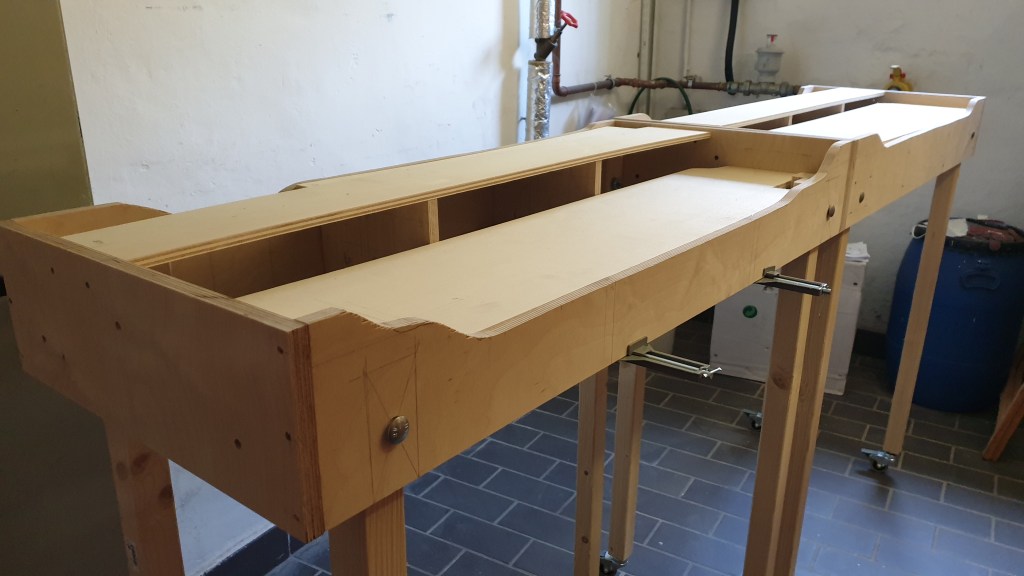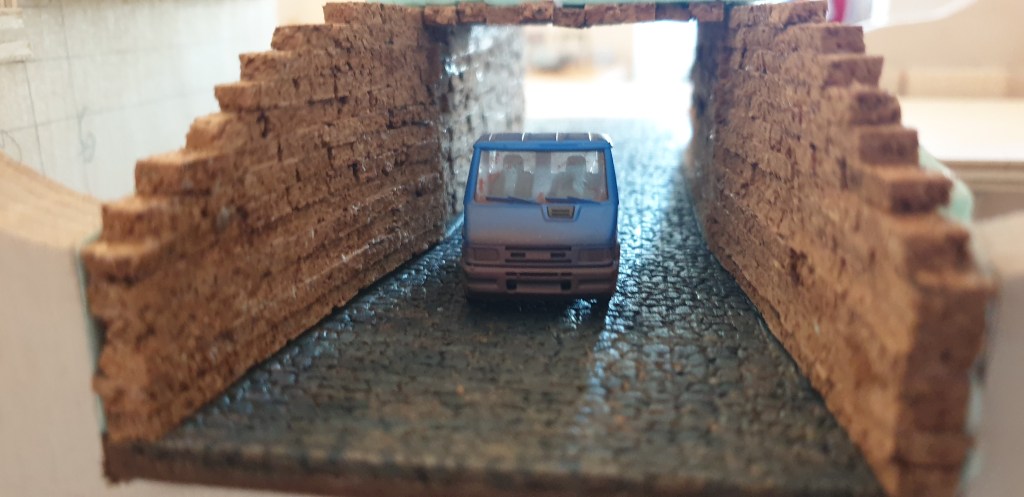Each Loewenherz module has the same dimensions 1080mm x 450mm x 150mm. The length 1080mm corresponds to the geometry of Märklin C-tracks. The width 450mm and height 150mm follows the MIST-61 end module standards to ensure interoperability with neighbouring modules.
I visualised Module 1a as the focal point for visitors. On the visitor side, there is a train viewing platform, where visitors and train fans alike can enjoy the view of the passing trains as they run along the platform. At visitors’ eye level, it makes an impressive sight.

Park visitors can enter the rest of the park from the south side (train viewing platform) via a pedestrian underpass which cuts underneath the main railway tracks to Bad Niedrigsrode. On the other side, visitors can enjoy a nice walk around the park. One railway exhibit is placed on a sandstone plinth.
The miniature park railway traverses across the park. On the west side, the miniature park railway makes a steep decline from a halt in Module 1b. A gravel path snakes besides this railway track and connects two modules.
As I built this module, some improvements and changes were made to the above concept. I will explain them in following progress photos.
Step 1: Frame for the Module 1a
I made sure that I plan and cut the contour of my module during the frame construction phase as it would be difficult to cut them later on when I add the baseboard on top.


The frame for Module 1a. I cut the contours on the long sides of the module (top) and the opening for the pedestrian underpass (bottom). (Foto: Jimmy Low (c))
The baseboards for each side and the main tracks rests on the module.

Step 2: Making Prototype Structures and Finding the Best Fit
4 visible key elements will be immediately noticeable on Module 1a i.e. the pedestrian underpass, train viewing platform, sandstone plinth and the miniature park railway track.
I made prototypes of the structures with 3mm/5mm foam board to gauge the feasibility and doability of the final structures. From such prototypes, I learned not only to how design the models to fit but also what could be the possible challenges in maintaining them later especially when it comes to wiring.

The pedestrian underpass was too short and not wide enough to cover the opening. Design-wise, I like how it will look. (Foto: Jimmy Low (c))
During its first “public” appearance in June 2022, I explained to my MIST-61 members the concept of Loewenherz railway park and the key elements. Below you see Module 1a and Module 1b connected to neighboring modules for the first time and trains could run through smoothly.

Pencil lines on the module 1a show the miniature park railway track. (Foto: Jimmy Low (c))

The eye level view of passing trains from the train viewing platform. See how excited our visitors are (Foto: Jimmy Low (c))
Step 3: Building the Final Structures and Surrounding Landscapes
Pedestrian Underpass
The pedestrian underpass really tested my model construction skills but the outcome is awesome. There is a back story about this underpass. The current underpass was built in 1872 connecting between the former industrial park (now the railway park) and other part of Bad Niedrigsrode. After years of wear and tear from the vehicles using that underpass, most of the cobblestones are now uneven and even darker in color (grease, sand etc.). The underpass was disused when the industrial park was closed for many decades and only revived when the park was opened in 1982.
Today the underpass is only for pedestrian usage and park service vehicles.




The retention walls are beginning to take shape at each end of the underpass. (Foto: Jimmy Low (c))
One side of the walls received the first weathering job. Finishing touches will be made later when other landscapes (filling the gaps at each side of the underpass) are completed.


The quantity surveyor made an initial inspection of the underpass und retention wall (Fotos: Jimmy Low (c))
Sandstone Plinth
The sandstone plinth is made from 3mm cork. The texture and color makes a good impression of worn stones due to the exposure to the elements.



Märklin 2022 donation 2nd class passenger car “Ukraine Hilfe” rests on the sandstone plinth (Foto: Jimmy Low (c))